It looks like you're using an Ad Blocker.
Please white-list or disable AboveTopSecret.com in your ad-blocking tool.
Thank you.
Some features of ATS will be disabled while you continue to use an ad-blocker.
share:
Hello, i thought i might share here some images and thoughts on the Good shepherd Dumuzid, the lover with the whip, as he is identified in the Frans
Wiggerman paper on this Divinity, also i'll quote Hymns to Inanna and Dumuzid.
The image of Dumuzid
 A. Moortgat identified Dumuzi (Tammuz) with a large number of different
figures, prominent among them the priest-king of protoliterate art, and the bearded hero with curly hair The basis for the identifications is again
Dumuzi’s quality of shepherd
A. Moortgat identified Dumuzi (Tammuz) with a large number of different
figures, prominent among them the priest-king of protoliterate art, and the bearded hero with curly hair The basis for the identifications is again
Dumuzi’s quality of shepherd
He must be an anthropomorphic figure that can be recognized as: shepherd; lover (of Inanna/Istar); ruler (of Uruk); of ambiguous divinity; or as dying and resurrecting god of vegetation. On principle the various iconographic expressions of Dumuzi’s character could occur in isolation, or be combined together in one image
The god is regularly associated with a lion: he has his feet on a couchant lion, while another jumps up out of the cup he holds in his hand; a crouching lion complements the pastoral scene in front of the deity. The lions are peacefully subdued, imressed no doubt by the authority of the shepherd-god.
The association of the lion in relationship to the Good Shepherd is interesting, in later times this developed into the wild exorcist of the steppe wearing a lion skin and casting out Demons.
The sojourn in the steppe is xpressed by the bow he carries and by what he wears instead of civilized clothing: a lion’s skin. Returning from the steppe the rustically clad god rings back vegetation, which is expressed by the stalks of grain growing from his body. Since steppe and Netherworld are one and the same in mythological contexts, the once absent and now returning god with grain rowing from his body can be recognized as a dying and resurrecting god of vegetation
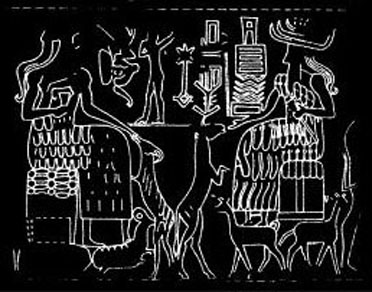 Together with his spouse Dumuzi features in an incantation-ritual against
sorcery, specifically “hate magic” and “cutting of the
Together with his spouse Dumuzi features in an incantation-ritual against
sorcery, specifically “hate magic” and “cutting of the
throat” , which caused, among other, loss of potency and involuntary emissions of sperm .
The ritual took place in the house of the victim, and involved a lawsuit against the sorcerers that was to result in his release from the grip of the Netherworld.
The proceedings were magically enacted by figurative representations of those concerned: the victim; Istar as judge; Dumuzi as witness
Bedu,the doorman of the Netherworld; and, with their arms tied on their back,the indicted witch and warlock. The prominent role of a divine couple is unque, and limited to the “Dumuzi and istar ncantation rituals.
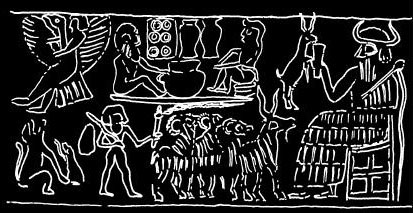
My desirable one, my desirable one, your charms are lovely, my desirable apple garden, your charms are lovely. My fruitful garden of mes trees, your charms are lovely, my one who is in himself Dumuzid-abzu, your charms are lovely
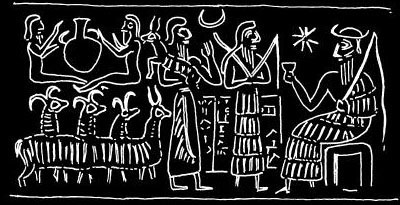
Good semen, good seed; when he comes forth from the brickbuilt abzu, I will make him sprout forth like a mes tree. Ama-ucumgal-ana, may An create, shall supply you with , Your sweet beauty, like foliage .. I shall cherish you ... I will make Ama-ucumgal-ana sprout forth as just such a mes tree
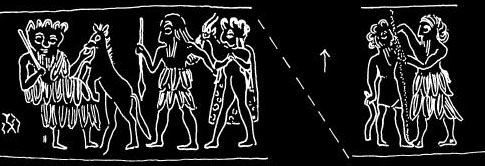
My lord is perfect for the holy embrace. Ama-ucumgal-ana, the son-in-law of Suen, lord Dumuzid, is perfect for the holy embrace. Ama-ucumgal-ana, son-in-law of Suen, my lord: how pleasing is your lavishness, and how sweet-tasting are your herbs and plants from the plain!
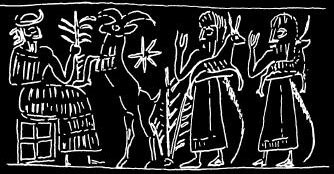
Inanna spoke:
"He brought me into his garden.
My brother, Dumuzi, brought me into his garden.
I strolled with him among the standing trees,
I stood with him among the fallen trees
By the apple tree I knelt as is proper.
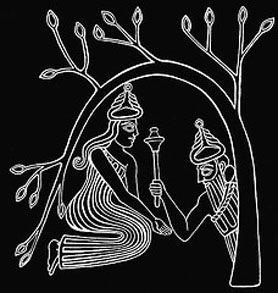
The honey man, the honey man will make me sweet; my lord, the honey man of a goddess, his mother's favourite, whose hands are honey, whose feet are honey, will make me sweet, whose limbs are honey-sweet, will make me sweet
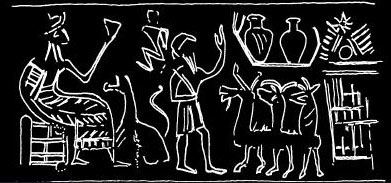
The shepherd was correlated to the King of Uruk, who ruled as consort of Inanna.
Ninsubur, the good minister of E-ana, clasps him by his right hand and brings him in bliss to Inana's embrace: "May the lord whom you have chosen in your heart, the king, your beloved husband, enjoy long days in your holy and sweet embrace! Give him a propitious and famous reign, give him a royal throne of kingship on its firm foundation, give him the sceptre to guide the Land, and the staff and crook, and give him the righteous headdress and the crown which glorifies the head! From the rising of the sun to the setting of the sun, from the south to the north, from the upper sea to the lower sea, from where the halub tree grows to where the cedar grows, over all Sumer and Akkad, grant him the staff and the crook!
"May he act as shepherd of the black-headed inhabitants; may he, like a farmer, make the fields productive; may he make the sheepfolds multiply, like a trustworthy shepherd. Under him, may there be flax, may there be barley; in the rivers may there be carp floods. Under him, may there be mottled barley in the fields; in the marshes, fish, and may the birds chatter. Under him, may the old reeds and the young reeds grow tall in the reed-beds; under him, may the macgurum bushes flourish on the high plains. Under him, may the wild sheep and wild goats multiply in the forests; under him, may the irrigated orchards produce syrup and wine. Under him, may lettuce and cress flourish in the garden plots; under him, may there be long life in the palace.
"May high flood-waters flow in the Tigris and Euphrates, may the grasses grow tall on their banks, and may the meadows be covered. May the holy lady Nisaba pile high the grain heaps and mounds. My lady, queen of heaven and earth, queen who encompasses heaven and earth, may he enjoy long days ...... embrace."
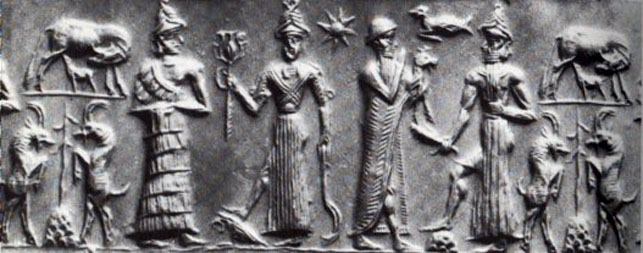
My desirable one, my desirable one, your charms are lovely, my desirable apple garden, your charms are lovely. My fruitful garden of mes trees, your charms are lovely, my one who is in himself Dumuzid-abzu, your charms are lovely. My holy statuette, my holy statuette, your charms are lovely. My alabaster statuette adorned with a lapis-lazuli jewel, your charms are lovely."
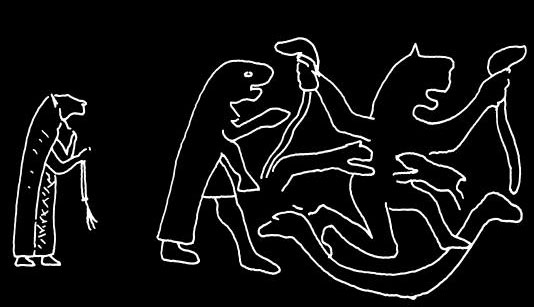
As the cult of Dumuzid and Inanna diminished in importance then, it was the figure Latarak that most closely resembled the former.
The iconographic features that support Latarak’s role in magic point unambiguosly to the steppe to his predecessor, Dumuzi of old.
They are the lion’s skin he wears and the whip he holds in his hand. The lion skin the typical trophy of a “king of the steppe,”makes him a slayer of evil, and thus a threat to demons, inhabitants of the steppe like he. It continues the peacefully subdued lions and the lion’s skin attributed to Dumuzi in earlier iconography.
The whip, which Latarak shares with his predecessor, serves to scare off the demons and put them to flight. This function of the whip is made explicit by first-millennium ritual texts, where it is used by the human exorcist that embodied Latarak or like gods during the magical proceedings
Apple Tree of Edin
The image of Dumuzid
 A. Moortgat identified Dumuzi (Tammuz) with a large number of different
figures, prominent among them the priest-king of protoliterate art, and the bearded hero with curly hair The basis for the identifications is again
Dumuzi’s quality of shepherd
A. Moortgat identified Dumuzi (Tammuz) with a large number of different
figures, prominent among them the priest-king of protoliterate art, and the bearded hero with curly hair The basis for the identifications is again
Dumuzi’s quality of shepherd He must be an anthropomorphic figure that can be recognized as: shepherd; lover (of Inanna/Istar); ruler (of Uruk); of ambiguous divinity; or as dying and resurrecting god of vegetation. On principle the various iconographic expressions of Dumuzi’s character could occur in isolation, or be combined together in one image
The god is regularly associated with a lion: he has his feet on a couchant lion, while another jumps up out of the cup he holds in his hand; a crouching lion complements the pastoral scene in front of the deity. The lions are peacefully subdued, imressed no doubt by the authority of the shepherd-god.
The association of the lion in relationship to the Good Shepherd is interesting, in later times this developed into the wild exorcist of the steppe wearing a lion skin and casting out Demons.
The sojourn in the steppe is xpressed by the bow he carries and by what he wears instead of civilized clothing: a lion’s skin. Returning from the steppe the rustically clad god rings back vegetation, which is expressed by the stalks of grain growing from his body. Since steppe and Netherworld are one and the same in mythological contexts, the once absent and now returning god with grain rowing from his body can be recognized as a dying and resurrecting god of vegetation
 Together with his spouse Dumuzi features in an incantation-ritual against
sorcery, specifically “hate magic” and “cutting of the
Together with his spouse Dumuzi features in an incantation-ritual against
sorcery, specifically “hate magic” and “cutting of the throat” , which caused, among other, loss of potency and involuntary emissions of sperm .
The ritual took place in the house of the victim, and involved a lawsuit against the sorcerers that was to result in his release from the grip of the Netherworld.
The proceedings were magically enacted by figurative representations of those concerned: the victim; Istar as judge; Dumuzi as witness
Bedu,the doorman of the Netherworld; and, with their arms tied on their back,the indicted witch and warlock. The prominent role of a divine couple is unque, and limited to the “Dumuzi and istar ncantation rituals.

My desirable one, my desirable one, your charms are lovely, my desirable apple garden, your charms are lovely. My fruitful garden of mes trees, your charms are lovely, my one who is in himself Dumuzid-abzu, your charms are lovely

Good semen, good seed; when he comes forth from the brickbuilt abzu, I will make him sprout forth like a mes tree. Ama-ucumgal-ana, may An create, shall supply you with , Your sweet beauty, like foliage .. I shall cherish you ... I will make Ama-ucumgal-ana sprout forth as just such a mes tree

My lord is perfect for the holy embrace. Ama-ucumgal-ana, the son-in-law of Suen, lord Dumuzid, is perfect for the holy embrace. Ama-ucumgal-ana, son-in-law of Suen, my lord: how pleasing is your lavishness, and how sweet-tasting are your herbs and plants from the plain!

Inanna spoke:
"He brought me into his garden.
My brother, Dumuzi, brought me into his garden.
I strolled with him among the standing trees,
I stood with him among the fallen trees
By the apple tree I knelt as is proper.

The honey man, the honey man will make me sweet; my lord, the honey man of a goddess, his mother's favourite, whose hands are honey, whose feet are honey, will make me sweet, whose limbs are honey-sweet, will make me sweet

The shepherd was correlated to the King of Uruk, who ruled as consort of Inanna.
Ninsubur, the good minister of E-ana, clasps him by his right hand and brings him in bliss to Inana's embrace: "May the lord whom you have chosen in your heart, the king, your beloved husband, enjoy long days in your holy and sweet embrace! Give him a propitious and famous reign, give him a royal throne of kingship on its firm foundation, give him the sceptre to guide the Land, and the staff and crook, and give him the righteous headdress and the crown which glorifies the head! From the rising of the sun to the setting of the sun, from the south to the north, from the upper sea to the lower sea, from where the halub tree grows to where the cedar grows, over all Sumer and Akkad, grant him the staff and the crook!
"May he act as shepherd of the black-headed inhabitants; may he, like a farmer, make the fields productive; may he make the sheepfolds multiply, like a trustworthy shepherd. Under him, may there be flax, may there be barley; in the rivers may there be carp floods. Under him, may there be mottled barley in the fields; in the marshes, fish, and may the birds chatter. Under him, may the old reeds and the young reeds grow tall in the reed-beds; under him, may the macgurum bushes flourish on the high plains. Under him, may the wild sheep and wild goats multiply in the forests; under him, may the irrigated orchards produce syrup and wine. Under him, may lettuce and cress flourish in the garden plots; under him, may there be long life in the palace.
"May high flood-waters flow in the Tigris and Euphrates, may the grasses grow tall on their banks, and may the meadows be covered. May the holy lady Nisaba pile high the grain heaps and mounds. My lady, queen of heaven and earth, queen who encompasses heaven and earth, may he enjoy long days ...... embrace."

My desirable one, my desirable one, your charms are lovely, my desirable apple garden, your charms are lovely. My fruitful garden of mes trees, your charms are lovely, my one who is in himself Dumuzid-abzu, your charms are lovely. My holy statuette, my holy statuette, your charms are lovely. My alabaster statuette adorned with a lapis-lazuli jewel, your charms are lovely."

As the cult of Dumuzid and Inanna diminished in importance then, it was the figure Latarak that most closely resembled the former.
The iconographic features that support Latarak’s role in magic point unambiguosly to the steppe to his predecessor, Dumuzi of old.
They are the lion’s skin he wears and the whip he holds in his hand. The lion skin the typical trophy of a “king of the steppe,”makes him a slayer of evil, and thus a threat to demons, inhabitants of the steppe like he. It continues the peacefully subdued lions and the lion’s skin attributed to Dumuzi in earlier iconography.
The whip, which Latarak shares with his predecessor, serves to scare off the demons and put them to flight. This function of the whip is made explicit by first-millennium ritual texts, where it is used by the human exorcist that embodied Latarak or like gods during the magical proceedings
Apple Tree of Edin
edit on 23-10-2013 by Kantzveldt because: (no reason given)
reply to post by Kantzveldt
That's very interesting, but it seems your source has Abzu misplaced. Abzu is the god of the waters, so what is brickbuilt?
The brickbuilt abzu?
And the whip is found throughout ancient Sumerian religions as well as Egyptian.
Tammuz was a god in Akkadian, and Tammuz is also a month in the Hebrew calendar. But of course the ancient Sumerians and Akkadians believed the gods and goddesses were married and practiced "sacred sex". This is a story of "sacred sex", and yes, the ancients believed in "sacred sperm", that's why they built structures for that worship. The ancients believed in the sacred male and female divine mating, so it makes sense then that the ancients did not have homosexual gods, until the Greeks. The Greeks also had gods that mated with animals.
Sheep were important in the ancient world, from sheep they got clothing and food, so it makes sense they would sacrifice such an important facet in their lives.
Have you seen the statue Ram caught in a thicket
Goats and sheep were fundamental to their lives, it makes sense then that sacrificing was so important.
That's very interesting, but it seems your source has Abzu misplaced. Abzu is the god of the waters, so what is brickbuilt?
The brickbuilt abzu?
And the whip is found throughout ancient Sumerian religions as well as Egyptian.
Tammuz was a god in Akkadian, and Tammuz is also a month in the Hebrew calendar. But of course the ancient Sumerians and Akkadians believed the gods and goddesses were married and practiced "sacred sex". This is a story of "sacred sex", and yes, the ancients believed in "sacred sperm", that's why they built structures for that worship. The ancients believed in the sacred male and female divine mating, so it makes sense then that the ancients did not have homosexual gods, until the Greeks. The Greeks also had gods that mated with animals.
Sheep were important in the ancient world, from sheep they got clothing and food, so it makes sense they would sacrifice such an important facet in their lives.
Have you seen the statue Ram caught in a thicket
Goats and sheep were fundamental to their lives, it makes sense then that sacrificing was so important.
reply to post by WarminIndy
The most important brick built Abzu shrine to Enki God of the waters was at Eridu, this was believed to provide entrance into the greater Abzu, in the context of Dumuzid and Uruk this may suggest there was also a shrine there.
Yes the whip was a common instrument of shepherds, used to knock down fruit from the trees for the goats and such forth, in later times it also seems to have been employed in beating out Demons.
If you look at the actual bottom seal in the OP you will see rams stood upright, as in the statue, what is represented there is the plant or tree of life in conjunction with the mountains of the Eastern and Western horizons, the point were entrance into the Heavens or Underworld were located.
Interesting also to see what appears to be cheese making going on in some of the seal illustrations, which is attested in Sumerian culture as far back as 5,000 years.
.
The most important brick built Abzu shrine to Enki God of the waters was at Eridu, this was believed to provide entrance into the greater Abzu, in the context of Dumuzid and Uruk this may suggest there was also a shrine there.
Yes the whip was a common instrument of shepherds, used to knock down fruit from the trees for the goats and such forth, in later times it also seems to have been employed in beating out Demons.
If you look at the actual bottom seal in the OP you will see rams stood upright, as in the statue, what is represented there is the plant or tree of life in conjunction with the mountains of the Eastern and Western horizons, the point were entrance into the Heavens or Underworld were located.
Interesting also to see what appears to be cheese making going on in some of the seal illustrations, which is attested in Sumerian culture as far back as 5,000 years.
.
edit on 23-10-2013 by Kantzveldt because: (no reason given)
reply to post by Kantzveldt
Fascinating summary and link-up, Kantz. Well done!
I think it might be prudent, for the benefit of those just stumbling across this thread (and the related Apple Tree of Edin thread) to mention the time-stamp for this information.
Seven thousand years ago, isn't it? Or between 7,000 and 4,000? They were around for a long time. Can you give us some sources for easy-reading intro to Sumerians? I've been meaning to dig into it; got hung up on the Abrahamic stuff, but almost ready to move on.
Excellent info. Thanks. (Though their 'poetry' leaves a bit to be desired, lol).
Fascinating summary and link-up, Kantz. Well done!
I think it might be prudent, for the benefit of those just stumbling across this thread (and the related Apple Tree of Edin thread) to mention the time-stamp for this information.
Seven thousand years ago, isn't it? Or between 7,000 and 4,000? They were around for a long time. Can you give us some sources for easy-reading intro to Sumerians? I've been meaning to dig into it; got hung up on the Abrahamic stuff, but almost ready to move on.
Excellent info. Thanks. (Though their 'poetry' leaves a bit to be desired, lol).
edit on 10/23/13 by wildtimes because: (no reason
given)
reply to post by Kantzveldt
Ok, I missed that, it means a shrine or a temple. But yes, I can see the sheep and goats standing upright. Do you think this may be the basis for Aries?
I have a theory and that is Aryans were worshipers of Aries. I don't know much about astrology or believe in it, but perhaps for those who did, the Aryans seem possible to derive from Aries?
On that seal also is Shamash, the sun god of Akkadia.
Ok, I missed that, it means a shrine or a temple. But yes, I can see the sheep and goats standing upright. Do you think this may be the basis for Aries?
I have a theory and that is Aryans were worshipers of Aries. I don't know much about astrology or believe in it, but perhaps for those who did, the Aryans seem possible to derive from Aries?
On that seal also is Shamash, the sun god of Akkadia.
reply to post by wildtimes
Much here will date to around 5,000 years ago, Uruk starting around 6,000 years ago as a city, though there was the earlier Ubaid culture in the region.
I think their verse is great for the period, and the cult of Inanna and Dumuzid is were the romantic side of the Divine is found, the one that humanity can most deeply relate to in terms of attachment.
The couple were often household Deity figurines, and even as seen when problems with wicked witches and sorcerers arose a little ritual involving the figurines could be played out, so they also had protective function.
reply to post by WarminIndy
They were moving into the zodiac sign of the ram rising in conjunction with the spring equinox/New Year at that period, from Taurus.
The figures on that seal could indicate Anu, Inanna, Dumuzid, Utu/Shamash (brother of Inanna), but i'm not certain of that.
The 'Ar' in Aryan is generally considered to mean 'high', whether in terms of nobility or from highlands opinions differ, a noble ram living on a high mountain would perhaps accomodate both
Much here will date to around 5,000 years ago, Uruk starting around 6,000 years ago as a city, though there was the earlier Ubaid culture in the region.
I think their verse is great for the period, and the cult of Inanna and Dumuzid is were the romantic side of the Divine is found, the one that humanity can most deeply relate to in terms of attachment.
The couple were often household Deity figurines, and even as seen when problems with wicked witches and sorcerers arose a little ritual involving the figurines could be played out, so they also had protective function.
reply to post by WarminIndy
They were moving into the zodiac sign of the ram rising in conjunction with the spring equinox/New Year at that period, from Taurus.
The figures on that seal could indicate Anu, Inanna, Dumuzid, Utu/Shamash (brother of Inanna), but i'm not certain of that.
The 'Ar' in Aryan is generally considered to mean 'high', whether in terms of nobility or from highlands opinions differ, a noble ram living on a high mountain would perhaps accomodate both
edit on 23-10-2013 by Kantzveldt because: (no reason given)
reply to post by Kantzveldt
I am not sure, but I read somewhere so it will take me time to find it, but didn't they use to put Shamash and Inanna as idols into a bed every night so they could copulate?
One time my brother took me to see his friend who wanted to read the tarot for me, she said all of this about Mars and Neptune or something being in some house and some moon...and I then asked her to explain all what she was saying. She never explained it to me. Then I asked her why which cards were more important, she never told me why, only that they were more important. Astrology then seems to me to be self-explained.
But if an entire culture or civilization is built on it, then it must have been very important for them. But since this area is north of the equator and didn't have knowledge of the southern hemisphere and constellations there, wouldn't astrology then only be localized?
No one knows who the Aryans really were, but it could be they did use astrology to define their worldview. I don't understand what you meant by Aries and Taurus, but aren't those Greek terms?
People called me crazy for saying that all religions in the near east have a common source as so many seem to be interrelated by the word usages. Shamash is the sun god and yet Shamash is also the middle candle of the menorah. To me, that kind of sounds very related. Today, it is in the Hebrew translated Bibles, but I am not sure if the translator inserted that, or if it were the original word.
Here is one such example...
Though they use the word shemesh here, it is not too far off from Shamash. This is the word for sun.
It is repeated in Psalm 84:11
As they didn't use a capital letter with shemesh, it does appear that the same word was used from the Akkadian to the Hebrew. I am not saying that the Hebrews believed in the natural as the supernatural, but to borrow words that have the same meaning, indicates they have the same source.
Either Shamash WAS the sun god to the most ancient Hebrews, or they merely applied the attributes of Shamash onto the sun. Either way, if it is to be taken literally, then the sun would be a god to them. But the Hebrews were forbidden to make images and believed in a God above creation, so then it is most likely attributes. And perhaps the Akkadians and Sumerians also believed in the attributes by merely representing a story in their inscriptions?
Shamash is mysterious, so much more study should be done on him. But I asked someone the other day, if the Bible specifically mentions the giants of old, the Nephilim, and that they were men of renown, then who were these men and why don't we know about their deeds they were famous for? Apparently the ancient Hebrews knew they were famous, but who were they?
Enter Sumerian and Akkadian, they might tell us who they were and what they did. Perhaps Shamash was one of those mighty men of renown?
I am not sure, but I read somewhere so it will take me time to find it, but didn't they use to put Shamash and Inanna as idols into a bed every night so they could copulate?
One time my brother took me to see his friend who wanted to read the tarot for me, she said all of this about Mars and Neptune or something being in some house and some moon...and I then asked her to explain all what she was saying. She never explained it to me. Then I asked her why which cards were more important, she never told me why, only that they were more important. Astrology then seems to me to be self-explained.
But if an entire culture or civilization is built on it, then it must have been very important for them. But since this area is north of the equator and didn't have knowledge of the southern hemisphere and constellations there, wouldn't astrology then only be localized?
No one knows who the Aryans really were, but it could be they did use astrology to define their worldview. I don't understand what you meant by Aries and Taurus, but aren't those Greek terms?
People called me crazy for saying that all religions in the near east have a common source as so many seem to be interrelated by the word usages. Shamash is the sun god and yet Shamash is also the middle candle of the menorah. To me, that kind of sounds very related. Today, it is in the Hebrew translated Bibles, but I am not sure if the translator inserted that, or if it were the original word.
Here is one such example...
Bereshis 15:12 Orthodox Jewish Bible (OJB) 12 And when the shemesh was going down, a tardemah fell upon Avram; and, hinei, a horror of great darkness fell upon him.
Though they use the word shemesh here, it is not too far off from Shamash. This is the word for sun.
It is repeated in Psalm 84:11
Tehillim 84:11 Orthodox Jewish Bible (OJB) 11 (12) For Hashem Elohim is a shemesh and a mogen; Hashem will give chen and kavod; no good thing will He withhold from the holekhim b’tamim (them that walk uprightly).
As they didn't use a capital letter with shemesh, it does appear that the same word was used from the Akkadian to the Hebrew. I am not saying that the Hebrews believed in the natural as the supernatural, but to borrow words that have the same meaning, indicates they have the same source.
Either Shamash WAS the sun god to the most ancient Hebrews, or they merely applied the attributes of Shamash onto the sun. Either way, if it is to be taken literally, then the sun would be a god to them. But the Hebrews were forbidden to make images and believed in a God above creation, so then it is most likely attributes. And perhaps the Akkadians and Sumerians also believed in the attributes by merely representing a story in their inscriptions?
Shamash is mysterious, so much more study should be done on him. But I asked someone the other day, if the Bible specifically mentions the giants of old, the Nephilim, and that they were men of renown, then who were these men and why don't we know about their deeds they were famous for? Apparently the ancient Hebrews knew they were famous, but who were they?
Enter Sumerian and Akkadian, they might tell us who they were and what they did. Perhaps Shamash was one of those mighty men of renown?
reply to post by WarminIndy
No they wouldn't do that because Utu/Shamash was the brother of Inanna, and even though he was very hot that couldn't have happened, it was Dumuzid that was the other half in the sacred marriage.
Aries and Taurus are of course the Greek names, but those constellations originate from Sumeria;

Shamash was the common Semitic name for the Sun, it would just seem with the Hebrews he became an aspect of Yahweh over time to me, still an aspect of the Divine but without the independent persona.
No they wouldn't do that because Utu/Shamash was the brother of Inanna, and even though he was very hot that couldn't have happened, it was Dumuzid that was the other half in the sacred marriage.
Aries and Taurus are of course the Greek names, but those constellations originate from Sumeria;

Shamash was the common Semitic name for the Sun, it would just seem with the Hebrews he became an aspect of Yahweh over time to me, still an aspect of the Divine but without the independent persona.
Kantzveldt
reply to post by WarminIndy
Shamash was the common Semitic name for the Sun, it would just seem with the Hebrews he became an aspect of Yahweh over time to me, still an aspect of the Divine but without the independent persona.
That does make sense.
I can see how it is much easier to take all the attributes and compile them under one persona. But like the Bible also says that God is over the council of the gods, and if there is a council of gods, then what gods are those?
If all these gods really existed, then perhaps each of them was set over particular areas? I mean like Yaweh, which was Canaanite, along with El and Ba'al, then Yaweh was set over Canaan while Shamash and Utu were set over Akkadia?
The Moabites worshiped Chemosh, and his mother was Astarte, and she was in Akkadia and Sumer. So perhaps there was some attribute-giving that left something out or put something onto these gods?
And Shamash was hot..lol. Yes, it seems he was very hot.
WarminIndy
reply to post by Kantzveldt
But if an entire culture or civilization is built on it, then it must have been very important for them. But since this area is north of the equator and didn't have knowledge of the southern hemisphere and constellations there, wouldn't astrology then only be localized?
No, when Mars is in Aries in the Northern hemisphere it is the same constellation in the Southern. The Ecliptic or the path on which the Sun, Moon and planets moves is the same in each hemisphere just like the rise and set is the same. They do not see the most northern constellations (nor do we see the southern), but those are not used in Astrology (That I am aware of)
If it is seasonal astrology then sure, but it is more due to the planets, sun and moon in the houses (constellations) and that correlation to the seasons. It might be mirrored in the South but they do have the same part of sky.
reply to post by WarminIndy
There is a progression seen in the bible were Yahweh is the particular God of Israel and the only one they should worship, to were he is the foremost in charge of all others, to were he is the only One and only supreme Deity of the Universe.
There is a progression seen in the bible were Yahweh is the particular God of Israel and the only one they should worship, to were he is the foremost in charge of all others, to were he is the only One and only supreme Deity of the Universe.
abeverage
WarminIndy
reply to post by Kantzveldt
But if an entire culture or civilization is built on it, then it must have been very important for them. But since this area is north of the equator and didn't have knowledge of the southern hemisphere and constellations there, wouldn't astrology then only be localized?
No, when Mars is in Aries in the Northern hemisphere it is the same constellation in the Southern. The Ecliptic or the path on which the Sun, Moon and planets moves is the same in each hemisphere just like the rise and set is the same. They do not see the most northern constellations (nor do we see the southern), but those are not used in Astrology (That I am aware of)
If it is seasonal astrology then sure, but it is more due to the planets, sun and moon in the houses (constellations) and that correlation to the seasons. It might be mirrored in the South but they do have the same part of sky.
I can see how that is, but I suppose I am asking this because of a line I had read in a book, I don't remember the name of the book now, but the line sticks with me, "How did those ancient mariners who guided their navigation by the constellations, feel when they saw the Southern Cross for the first time?"
I think it is that aspect that makes me think that there must be something in the southern hemisphere that causes a slight different astrology than the northern. And thinking about that, what about those who saw the Aurora Bourealis for the first time? Those are amazing things, and I am sure the ancients viewed it with as much wonder.
How did they view the meteor showers? I am sure if they didn't know they were meteors then it would appear to them that the gods must be angry. Even at Tunguska, those natives did not seem to be aware of what hit them, either.
Kantzveldt
reply to post by WarminIndy
There is a progression seen in the bible were Yahweh is the particular God of Israel and the only one they should worship, to were he is the foremost in charge of all others, to were he is the only One and only supreme Deity of the Universe.
That goes back to the Elohist vs. Yawhist writings. As Yaweh and El seem to be two different gods found within the Ugarit texts, then maybe those who saw Him as El wrote the verses about the natural attributes? We see in that particular way of thinking, God is referred to as riding on a cloud and being the sun. And yet the Sun of Rightousness symbol is found in Egypt and in Persia for the Zoroastrians. Ahura Mazda was on a sun disk with feathers, just like we see in Malachi, "The Sun of Righteousness will arise with healing in his wings".
I am not one who thinks we should replace words for words, too much of that has been done. But as Christians believe this is prophetic about Jesus and do change Sun for Son, then that does give the Bible a different meaning. It then places Jesus as the Sun.
I think if the Bible say Sun then it should be left as Sun. The writer meant Sun, so going by that context, was the writer taking a naturalistic view of God? And if so, then by that context, those verses written by the Elohists would seem to be saying God is a natural aspect, but if the Yahwists wrote it, then that means they were giving sunlike attributes to God.
I am a Christian, but I can't live in denial of what the Bible actually says. And if the Bible implies that some writers felt God was natural, then that is acceptable to me. But since they borrowed symbolism from everywhere, maybe in their formation of organizing their religion, they didn't have all the wrinkles ironed out yet?
We might read the context, but ultimately, we just don't know what the writer was thinking. And if we believe the Bible was inspired by God, and as Paul said "All scripture..." then to what scriptures was he referring to? He then quotes from the book of Enoch. So if he felt the book of Enoch was proper to be read and it was inspired as well, why don't we have the book of Enoch?
If I believe that ALL scripture is profitable and inspired, then I can't dismiss any scripture, even if that scripture is Sumerian, Ugarit or Akkadian, since they all came from the same place, in my opinion. I would have to say the Avestas, which Paul probably had access to, are also profitable and inspired. He didn't make the distinction that it was only the Hebrew scriptures (boy, am I going to be in trouble for this one), but said ALL.
I do find the Rig Vedas to contain God and truth, so I am inclined to say those scriptures probably are inspired as well. (Boy, I REALLY am in trouble now). But I can only go with what my faith teaches me, and if it says something like that, then I have to accept it.
Maybe that's why I am a literalist, for those parts.
WarminIndy
I can see how that is, but I suppose I am asking this because of a line I had read in a book, I don't remember the name of the book now, but the line sticks with me, "How did those ancient mariners who guided their navigation by the constellations, feel when they saw the Southern Cross for the first time?"
I think it is that aspect that makes me think that there must be something in the southern hemisphere that causes a slight different astrology than the northern. And thinking about that, what about those who saw the Aurora Bourealis for the first time? Those are amazing things, and I am sure the ancients viewed it with as much wonder.
How did they view the meteor showers? I am sure if they didn't know they were meteors then it would appear to them that the gods must be angry. Even at Tunguska, those natives did not seem to be aware of what hit them, either.
I am sure they felt they had crossed (pun intact) into uncharted territory. There are most definitely different tales and myths of the different constellations in the Southern Hemisphere. As far as the Aurora they also get the less well known Aurora australis or southern lights. They were believed to be the dancing gods twirling in the sky. Or the sky fire that was bad omen, not to different from some northern counterparts.
edit on 23-10-2013 by abeverage because: of shimmering lights
reply to post by abeverage
That's a good link, I am reading it. And it does talk about Dreamtime. But I noticed that they even have a flood story, albeit just a little different. There the flood happened because women heard the secret of the mens' ceremony.
Interesting perspectives from them though.
That's a good link, I am reading it. And it does talk about Dreamtime. But I noticed that they even have a flood story, albeit just a little different. There the flood happened because women heard the secret of the mens' ceremony.
Interesting perspectives from them though.
WarminIndy
One time my brother took me to see his friend who wanted to read the tarot for me, she said all of this about Mars and Neptune or something being in some house and some moon...and I then asked her to explain all what she was saying. She never explained it to me. Then I asked her why which cards were more important, she never told me why, only that they were more important. Astrology then seems to me to be self-explained.
But if an entire culture or civilization is built on it, then it must have been very important for them. But since this area is north of the equator and didn't have knowledge of the southern hemisphere and constellations there, wouldn't astrology then only be localized?
It is not that the 'entire culture was built upon it', the astrological chart was used to determine the planetary conditions experienced by the individual during the pregnancy, rather than simply the point of birth as most modern astrologer do, in order to ascertain, how those conditions may have affected character and general 'healthiness. The role of medicine/healing was not so much aimed at 'cure' but an attempt to balance those predetermined attributes to invoke health and wellbeing; a functional member of the community. That their medicine was successful, meant that it's practitioners were highly valued and revered, and that the community as a whole, worked as a whole. Ancient medicine is all about the 'whole', hence the importance of collective ritual to combat disease and famine. If everyone wasn't involved, then the ritual may not be successful and all would suffer as a result. So, while the culture was not built upon astrology, astrology was an activity that encompassed everyone within that civilisation, due to it's role in maintaining the health of the group. An unhealthy individual within that group could impact on numerous aspects of life, including whether the crops would succeed or fail...so ensuring that everyone was astrologically balanced was imperative. In Sumerian, DA-IA-U-NA means 'power of fertility', it is where the word 'demon' derives, and in transliteration means, 'disease demon'. Astrology was the means by which the Sumerians predicted and countered possible problems, or demons, that could impinge upon their success as a group/civilisation.
Zodiacal charts are essentially localised, based on date and place of birth, and the configuration for that given period relationally.
reply to post by WarminIndy
The Old Testament figure of El as Lord of Hosts most closely corresponds with that of the Sumerian Anu, the most telling story for me is when El appears to Abraham at the plain of Mamre in conjunction with two others, described as Angels, but probably to be understood as Enki and Enlil originally.
These may interest you in this regard, in that Mamre became a gathering place for all Semitic peoples to celebrate the event. Going back to what you mentioned, i tend to consider the Sumerian Gods as starting off as City State Deities then moving on to the National scene in Semitic regions, with slight variations to names and attributes.
Construction of Nephilim pt 1
Constructions of Nephilim pt 2
With you mentioning the Sun i was reminded of this seal i came across today and was trying to figure, it appears to show a shepherd type figure, with whip, rising as and with the Sun, from the Akkadian period, could be the resurrection of Dumuzid
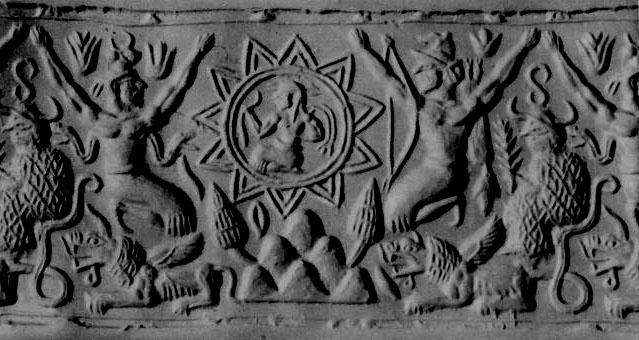
reply to post by KilgoreTrout
It is a very good paper, there are several others of his that it would interest me to base threads on, but it can all be a little specialized so the challenge is how to interest others!
The Old Testament figure of El as Lord of Hosts most closely corresponds with that of the Sumerian Anu, the most telling story for me is when El appears to Abraham at the plain of Mamre in conjunction with two others, described as Angels, but probably to be understood as Enki and Enlil originally.
These may interest you in this regard, in that Mamre became a gathering place for all Semitic peoples to celebrate the event. Going back to what you mentioned, i tend to consider the Sumerian Gods as starting off as City State Deities then moving on to the National scene in Semitic regions, with slight variations to names and attributes.
Construction of Nephilim pt 1
Constructions of Nephilim pt 2
With you mentioning the Sun i was reminded of this seal i came across today and was trying to figure, it appears to show a shepherd type figure, with whip, rising as and with the Sun, from the Akkadian period, could be the resurrection of Dumuzid

reply to post by KilgoreTrout
It is a very good paper, there are several others of his that it would interest me to base threads on, but it can all be a little specialized so the challenge is how to interest others!
edit on 23-10-2013 by Kantzveldt because: (no reason given)
reply to post by Kantzveldt
I don't have any answers for those buildings, but whoever did them certainly did a great job. I read the links, but as the ancient Hebrews mentioned and gave credence to the Nephilim, I am going to just say I don't know who they were and perhaps if archeologists keep digging, maybe they will find some text with a name attached.
The other seal, it strikes me about how creative they were. They thought to make the sun rays in almost 3D. I think those mountains show the steppe pyramids. They put everything they could think of into that inscription, but as the male and female are sitting on the thrones praising that god rising in the sun.
I don't have any answers for those buildings, but whoever did them certainly did a great job. I read the links, but as the ancient Hebrews mentioned and gave credence to the Nephilim, I am going to just say I don't know who they were and perhaps if archeologists keep digging, maybe they will find some text with a name attached.
The other seal, it strikes me about how creative they were. They thought to make the sun rays in almost 3D. I think those mountains show the steppe pyramids. They put everything they could think of into that inscription, but as the male and female are sitting on the thrones praising that god rising in the sun.
reply to post by Kantzveldt
Oh, I just realized something, both of the sphinxes are facing the same direction. I think they would have thought to put everything of importance into their inscription. They are telling a story.
I was educated as a filmmaker, so I critique narrative, because narrative is what the film is about. so looking at the narrative and knowing that everything is put into a scene by the director, what is the director telling us in this inscription?
The iconography suggests to me that even though the sun is rising in the middle in the east. As the sphinx are looking in the same direction, this can't be in a temple, because a temple would be set up to show the sphinx as cornerstones or pillars, as an entrance. The woman would be in the north and the man would be in the south.
The mountains are beneath the sun, so this is definitely something set in heaven or the sky. but wheat and sheep are displayed. So this viewer had to be standing in a wheat field surrounded by sheep, And as this is the rise of the Shepherd, then all of heaven and earth rejoice at the rise of the Shepherd.
I don't recall there being any large sphinx outside of Egypt, but both of these face the same direction. Maybe there had been at one time. The sphinx are closer to the viewer, so it implies that in the distance, the viewer or maker of the inscription watched the sun rise over the mountains and the pyramids. Imagine this in 3D, then you are looking eastward to the distance. Facing eastward is important, it is to the east that has so much importance even in the Bible. We believe Christ returns from the East, even Jesus said "As lightning shines from the east unto the west". As Christ is called the Good Shepherd, then perhaps this is a prophetic vision?
We do know that Solomon's temple did have sphinx in front of it, and inside it just in front of the ark of the covenant. The sheep have shofars on each side of the inscription. The ancient Hebrews were not the only ones to use shofars. So the story being told, that I think is being told, is that all of heaven and earth rejoice the rising of the Good Shepherd. It could be that those worshipers stood far enough away from the mountains to watch the sun rise over them.
Oh, I just realized something, both of the sphinxes are facing the same direction. I think they would have thought to put everything of importance into their inscription. They are telling a story.
I was educated as a filmmaker, so I critique narrative, because narrative is what the film is about. so looking at the narrative and knowing that everything is put into a scene by the director, what is the director telling us in this inscription?
The iconography suggests to me that even though the sun is rising in the middle in the east. As the sphinx are looking in the same direction, this can't be in a temple, because a temple would be set up to show the sphinx as cornerstones or pillars, as an entrance. The woman would be in the north and the man would be in the south.
The mountains are beneath the sun, so this is definitely something set in heaven or the sky. but wheat and sheep are displayed. So this viewer had to be standing in a wheat field surrounded by sheep, And as this is the rise of the Shepherd, then all of heaven and earth rejoice at the rise of the Shepherd.
I don't recall there being any large sphinx outside of Egypt, but both of these face the same direction. Maybe there had been at one time. The sphinx are closer to the viewer, so it implies that in the distance, the viewer or maker of the inscription watched the sun rise over the mountains and the pyramids. Imagine this in 3D, then you are looking eastward to the distance. Facing eastward is important, it is to the east that has so much importance even in the Bible. We believe Christ returns from the East, even Jesus said "As lightning shines from the east unto the west". As Christ is called the Good Shepherd, then perhaps this is a prophetic vision?
We do know that Solomon's temple did have sphinx in front of it, and inside it just in front of the ark of the covenant. The sheep have shofars on each side of the inscription. The ancient Hebrews were not the only ones to use shofars. So the story being told, that I think is being told, is that all of heaven and earth rejoice the rising of the Good Shepherd. It could be that those worshipers stood far enough away from the mountains to watch the sun rise over them.
new topics
-
Statements of Intent from Incoming Trump Administration Members - 2025 to 2029.
2024 Elections: 1 hours ago -
Could Biden pardon every illegal alien
Social Issues and Civil Unrest: 2 hours ago -
Stop the Presses! Turkey Soup.
Food and Cooking: 2 hours ago -
'Proud Prophet' 12 Day Exercise Predicted Global Nuclear Catastrophe
World War Three: 7 hours ago -
Never say Never?
Science & Technology: 11 hours ago
top topics
-
Lies lies lies, green energy is black.
The Gray Area: 17 hours ago, 13 flags -
Never say Never?
Science & Technology: 11 hours ago, 9 flags -
Could Biden pardon every illegal alien
Social Issues and Civil Unrest: 2 hours ago, 5 flags -
'Proud Prophet' 12 Day Exercise Predicted Global Nuclear Catastrophe
World War Three: 7 hours ago, 4 flags -
Stop the Presses! Turkey Soup.
Food and Cooking: 2 hours ago, 3 flags -
Statements of Intent from Incoming Trump Administration Members - 2025 to 2029.
2024 Elections: 1 hours ago, 2 flags
active topics
-
'Proud Prophet' 12 Day Exercise Predicted Global Nuclear Catastrophe
World War Three • 14 • : berbofthegreen -
Biden pardons his son Hunter despite previous pledges not to
Mainstream News • 106 • : WeMustCare -
Lies lies lies, green energy is black.
The Gray Area • 29 • : BeyondKnowledge3 -
The Acronym Game .. Pt.4
General Chit Chat • 997 • : JJproductions -
Could Biden pardon every illegal alien
Social Issues and Civil Unrest • 18 • : WeMustCare -
Statements of Intent from Incoming Trump Administration Members - 2025 to 2029.
2024 Elections • 2 • : WeMustCare -
President-Elect Trump Picks Indian-American KASHYAP P. PATEL for F.B.I. Director.
2024 Elections • 56 • : WeMustCare -
-@TH3WH17ERABB17- -Q- ---TIME TO SHOW THE WORLD--- -Part- --44--
Dissecting Disinformation • 3455 • : WeMustCare -
Stop the Presses! Turkey Soup.
Food and Cooking • 1 • : nugget1 -
Unidentified Flying Objects Over U.S. Military Bases in Northeast UK, as of roughly 11 a.m. CST.
Aliens and UFOs • 39 • : ElitePlebeian2
